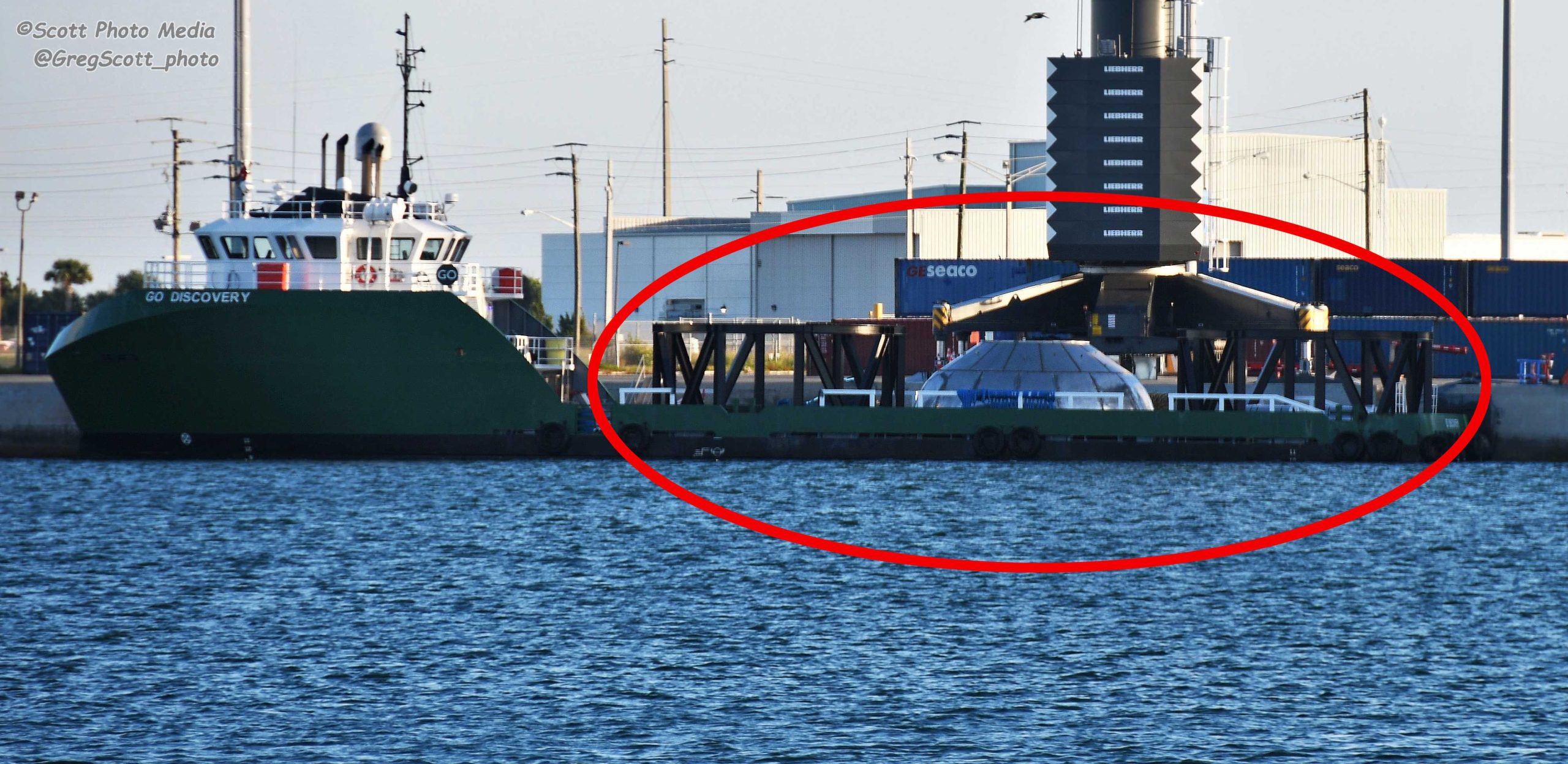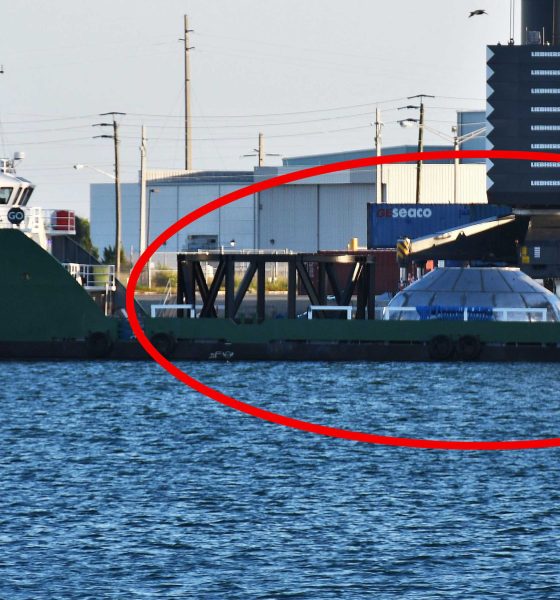

News
SpaceX Starship hardware mystery solved amid reports of Florida factory upheaval
A SpaceX Starship hardware mystery has been effectively solved after rocket parts arrived at Port Canaveral and were loaded aboard a transport ship, seemingly preparing for an unexpected journey by sea.
In an unexpected turn of events, SpaceX appears to be preparing to ship major Starship hardware from its Cocoa, Florida facility to a similar worksite in Boca Chica, Texas. Spotted for the first time in a photo taken by local photographer Greg Scott on November 30th, that hardware – at least two large stands and a nearly-complete steel tank dome – abruptly appeared beside SpaceX’s Port Canaveral dock space.
Seemingly within hours of their appearance, new vessel GO Discovery also arrived in Port Canaveral and parked by the same SpaceX docks. Shortly thereafter, workers loaded her with both build stands and a Starship tank dome and secured the surprise cargo. As it turns out, another local SpaceX-follower and prolific photographer/videographer happened to capture the disappearance of both stands and dome from SpaceX’s nearby Cocoa, FL Starship construction facility, where Starship Mk2 and Starship Mk4 were being built.
This neatly ties up the minor mystery of where that hardware went: SpaceX clearly moved all three parts to Port Canaveral, where they have since been loaded on a small supply ship. Two main questions remain, however: why have they been moved to the port and where are they headed?
The band is breaking up
Unfortunately, it appears that both questions can effectively be answered by a report published by YouTube channel “What about it?!”. According to former Cocoa employee that spoke to reporter and channel creator Felix Schlang, SpaceX has reportedly transferred up to 80% of the Starship facility’s workforce to other groups in Florida and Texas. Instead of the friendly internal competition that pitted Cocoa against Boca Chica in the race to first Starship flight, SpaceX is temporarily slowing down its Florida build operations and will redirect as much of its workforce and resources as possible to Boca Chica.
According to Schlang’s source, this will likely result in several months of relative downtime in Florida, while he was also told that Starship Mk2 and Mk4 are now effectively dead before arrival as a result of several challenging and reoccurring technical issues. Starship Mk2 likely shares some significant heritage with Starship Mk1, which lost its top during a pressure test. Roughly two-dozen steel Starship Mk4 rings may also be scrapped after SpaceX’s Florida team could not overcome a technical hurdle. Per the source, many of those single-weld steel rings were slightly different diameters, making it next to impossible to build a sound pressure vessel (i.e. Starship Mk4) with them.
Combining the appearance of Starship hardware on GO Discovery just yesterday and reports of major Cocoa layoffs, it’s all but certain that the Starship components on Discovery are going to head to Boca Chica, Texas. Schlang’s source also indicated that all affected employees were given the option to transfer to Boca Chica or Hawthorne, a prime indication that this abrupt change in plans is more a strategic move than a financial one. With any luck, most affected employees will be able to transfer to Florida pad operations or Boca Chica, although such a major and abrupt change is likely a no-go for anyone with major ties to South Florida.
The Starship dome and stands now likely headed for Boca Chica were built over the course of a month or two in Florida, meaning that they were either built under the impression that they would support Boca Chica’s Starship Mk3 prototype or repurposed after SpaceX decided to pause work in Cocoa. Of note, something like 8-12 of Starship Mk4’s steel rings were able to be stacked and all of those double-rings are still present at SpaceX Cocoa, while a number of single rings were indeed scrapped over the last few weeks. A header tank was also reportedly removed from Starship Mk2’s more or less finished nose section. If any of that hardware is technically viable, there’s a good chance that they may also be shipped to Texas to expedite Starship Mk3 integration.
Ultimately, given how rapidly SpaceX makes and changes decisions, pausing work in Cocoa doesn’t come as much of a surprise. It’s also far from the end of SpaceX’s Florida Starship-building efforts – Schlang indicates that SpaceX will instead focus on a similar facility located within Kennedy Space Center, making the process of building Starships offsite and transporting to Launch Pad 39A far more viable.
With this latest surprise, it also appears that SpaceX is now laser-focused on getting Starship Mk3 ready for South Texas flight testing. Stay tuned for an update on a flurry of recent developments at SpaceX’s Boca Chica Starship facilities.
Check out Teslarati’s Marketplace! We offer Tesla accessories, including for the Tesla Cybertruck and Tesla Model 3.

News
Tesla FSD fleet is nearing 7 billion total miles, including 2.5 billion city miles
As can be seen on Tesla’s official FSD webpage, vehicles equipped with the system have now navigated over 6.99 billion miles.

Tesla’s Full Self-Driving (Supervised) fleet is closing in on almost 7 billion total miles driven, as per data posted by the company on its official FSD webpage.
These figures hint at the massive scale of data fueling Tesla’s rapid FSD improvements, which have been quite notable as of late.
FSD mileage milestones
As can be seen on Tesla’s official FSD webpage, vehicles equipped with the system have now navigated over 6.99 billion miles. Tesla owner and avid FSD tester Whole Mars Catalog also shared a screenshot indicating that from the nearly 7 billion miles traveled by the FSD fleet, more than 2.5 billion miles were driven inside cities.
City miles are particularly valuable for complex urban scenarios like unprotected turns, pedestrian interactions, and traffic lights. This is also the difference-maker for FSD, as only complex solutions, such as Waymo’s self-driving taxis, operate similarly on inner-city streets. And even then, incidents such as the San Francisco blackouts have proven challenging for sensor-rich vehicles like Waymos.
Tesla’s data edge
Tesla has a number of advantages in the autonomous vehicle sector, one of which is the size of its fleet and the number of vehicles training FSD on real-world roads. Tesla’s nearly 7 billion FSD miles then allow the company to roll out updates that make its vehicles behave like they are being driven by experienced drivers, even if they are operating on their own.
So notable are Tesla’s improvements to FSD that NVIDIA Director of Robotics Jim Fan, after experiencing FSD v14, noted that the system is the first AI that passes what he described as a “Physical Turing Test.”
“Despite knowing exactly how robot learning works, I still find it magical watching the steering wheel turn by itself. First it feels surreal, next it becomes routine. Then, like the smartphone, taking it away actively hurts. This is how humanity gets rewired and glued to god-like technologies,” Fan wrote in a post on X.
News
Tesla starts showing how FSD will change lives in Europe
Local officials tested the system on narrow country roads and were impressed by FSD’s smooth, human-like driving, with some calling the service a game-changer for everyday life in areas that are far from urban centers.

Tesla has launched Europe’s first public shuttle service using Full Self-Driving (Supervised) in the rural Eifelkreis Bitburg-Prüm region of Germany, demonstrating how the technology can restore independence and mobility for people who struggle with limited transport options.
Local officials tested the system on narrow country roads and were impressed by FSD’s smooth, human-like driving, with some calling the service a game-changer for everyday life in areas that are far from urban centers.
Officials see real impact on rural residents
Arzfeld Mayor Johannes Kuhl and District Administrator Andreas Kruppert personally tested the Tesla shuttle service. This allowed them to see just how well FSD navigated winding lanes and rural roads confidently. Kruppert said, “Autonomous driving sounds like science fiction to many, but we simply see here that it works totally well in rural regions too.” Kuhl, for his part, also noted that FSD “feels like a very experienced driver.”
The pilot complements the area’s “Citizen Bus” program, which provides on-demand rides for elderly residents who can no longer drive themselves. Tesla Europe shared a video of a demonstration of the service, highlighting how FSD gives people their freedom back, even in places where public transport is not as prevalent.
What the Ministry for Economic Affairs and Transport says
Rhineland-Palatinate’s Minister Daniela Schmitt supported the project, praising the collaboration that made this “first of its kind in Europe” possible. As per the ministry, the rural rollout for the service shows FSD’s potential beyond major cities, and it delivers tangible benefits like grocery runs, doctor visits, and social connections for isolated residents.
“Reliable and flexible mobility is especially vital in rural areas. With the launch of a shuttle service using self-driving vehicles (FSD supervised) by Tesla in the Eifelkreis Bitburg-Prüm, an innovative pilot project is now getting underway that complements local community bus services. It is the first project of its kind in Europe.
“The result is a real gain for rural mobility: greater accessibility, more flexibility and tangible benefits for everyday life. A strong signal for innovation, cooperation and future-oriented mobility beyond urban centers,” the ministry wrote in a LinkedIn post.
News
Tesla China quietly posts Robotaxi-related job listing
Tesla China is currently seeking a Low Voltage Electrical Engineer to work on circuit board design for the company’s autonomous vehicles.

Tesla has posted a new job listing in Shanghai explicitly tied to its Robotaxi program, fueling speculation that the company is preparing to launch its dedicated autonomous ride-hailing service in China.
As noted in the listing, Tesla China is currently seeking a Low Voltage Electrical Engineer to work on circuit board design for the company’s autonomous vehicles.
Robotaxi-specific role
The listing, which was shared on social media platform X by industry watcher @tslaming, suggested that Tesla China is looking to fill the role urgently. The job listing itself specifically mentions that the person hired for the role will be working on the Low Voltage Hardware team, which would design the circuit boards that would serve as the nervous system of the Robotaxi.
Key tasks for the role, as indicated in the job listing, include collaboration with PCB layout, firmware, mechanical, program management, and validation teams, among other responsibilities. The role is based in Shanghai.
China Robotaxi launch
China represents a massive potential market for robotaxis, with its dense urban centers and supportive policies in select cities. Tesla has limited permission to roll out FSD in the country, though despite this, its vehicles have been hailed as among the best in the market when it comes to autonomous features. So far, at least, it appears that China supports Tesla’s FSD and Robotaxi rollout.
This was hinted at in November, when Tesla brought the Cybercab to the 8th China International Import Expo (CIIE) in Shanghai, marking the first time that the autonomous two-seater was brought to the Asia-Pacific region. The vehicle, despite not having a release date in China, received a significant amount of interest among the event’s attendees.








